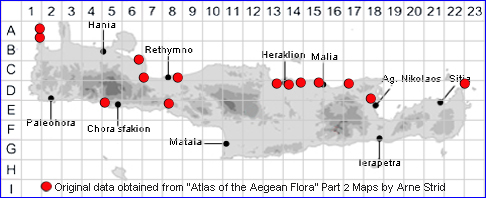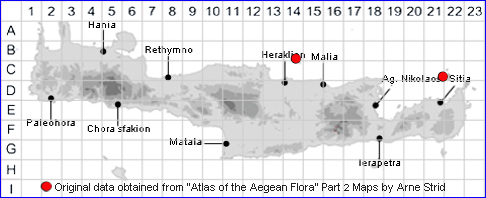

SPECIES DESCRIPTION
TRIGONELLA CORNICULATA Subsp. BALANSAE
Including Trigonella corniculata subsp. rechingeri
Family and Genus:- See- LEGUMINOSAE/Subgen. TRIGONELLA
Common Names:- None
Synonyms:- Trigonella sartorii.
Meaning:- Trigonella (L) Triangle, the perianth seen from the front.
Corniculata (L) Having a small horn or spur-like appendage.
Balansae (L) For Benjamin Balansa (1825-92) French plant collector.
General description:- Procumbent to erect annual
Stems:-
1) 10-40 cm, procumbent to erect, glabrous or puberulent.
Leaves:-
1) Pinnately 3-foliolate.
a) leaflets, 10-40 x 7-35 mm, linear-lanceolate to obovate, obtuse, sometimes
emarginate.
Flowers:-
1) Racemes, at anthesis, 8- to 15-flowered.
2) Peduncles, up to 6 cm.
3) Pedicels, c. 3 mm.
4) Calyx, 3-4 mm.
a) teeth, unequal, as long as or shorter than the tube.
5) Corolla, 6-7 mm, yellow.
a) wings, equalling the keel.
Fruit:-
1) Legume, 2-4 mm wide, subacute, pendent, linear, acuminate, compressed.
somewhat curved, glabrous, with thin transverse veins.
3) Seeds, 1-1·5 mm, oblong, tuberculate.
Key features:-
1) Wings, as long as the keel.
2) Legume, subacute.
Habitat:- Dry, open habitats, dry open shrubby vegetation 0-800(-1300) m.
Distribution:- East Mediterranean area. On Crete scattered mainly along the north
coast.
Flowering time:- Late Mar to early June.
Photo by:- Steve Lenton
TRIGONELLA CORNICULATA Subsp. BALANSAE Back to Top
Meaning: Rechingeri (L) Possibly for the Austrian botanist Karl Rechinger (1867-
1952).
Resembling T. subsp. balansae but differing in the following characters.
1) Stems, 5-20 cm, sparsely pubescent or subglabrous.
2) Leaflets, 7-10 × 7-9 mm, obovate, denticulate, glabrous or subglabrous.
3) Racemes, capitate, 6- to 10-flowered.
4) Peduncles, c. 1·5 cm.
5) Pedicels, 1·5-2 mm.
6) Calyx, 3-4 mm.
a) teeth, unequal, the longest about equalling the tube;
7) Legume, 10-14 × 3-4 mm, pendent, oblong, glabrous, with transverse veins.
a) Seeds, 1·5-2 mm, ovoid, yellow, finely tuberculate.
Photos currently unavailable
~~~~~~~~~~~~~~~~~~~~~~~~~~~~~~~~~~~~~~~~~~~~~~~~~~~~~~~~
